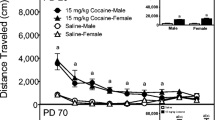The effect of the developing nucleus accumbens and ventrolateral striatum on grooming behavior in rat pups (1st month of life) and adult rats (2-12 months of life) was studied during activation of D1 and D2 dopamine receptors with apomorphine. Over the 1st week of life, apomorphine treatment was followed by hypersensitivity of D1 receptors in the nucleus accumbens. It was manifested in the early appearance of scratching and washing movements during ontogeny. The effect of activation was reduced after neonatal gangliosympathectomy. D2 receptors in the nucleus accumbens are identifi ed on day 22 of life. D2 receptors in the ventrolateral striatum become functionally active during this period. Under these conditions, apomorphine increased signifi cantly the duration of licking and biting movements. The number of D2 receptors in the ventrolateral striatum increases sharply during sexual maturity (2nd month of life). These changes are accompanied by an increase in the duration of oral stereotyped behavior. The duration of grooming movements was signifi cantly reduced by the end of stereotyped behavior. The effect of apomorphine was most pronounced in 9-month-old animals. We conclude that the immature ventrolateral striatum has a reciprocal stimulatory effect on licking and biting movements during ontogeny. By contrast, the mature striatum produces a subordinate reciprocal inhibitory infl uence on various types of grooming movements.
Similar content being viewed by others
References
L. M. Lepekhina, Adaptive and Graphic Infl uence of the Cervical Sympathetic Ganglia during Ontogeny [in Russian], Leningrad (1984).
R. Brus, A. Plech, and R. M. Kostrzena, Pharmacol. Biochem. Behav., 50, No. 4, 649-653 (1995).
J. M. Delfs and A. E. Kelley, Neuroscience, 39, No. 1, 59-67 (1990).
G. Flores, G. K. Wood, and J. J. Liang, J. Neurosci., 16, No. 22, 7366-7375 (1996).
Z. Merali and H. Piggins, Eur. J. Pharmacol., 191, No. 3, 281- 293 (1990).
A. Murray and J. L. Waddington, Pharmacol. Biochem. Behav., 35, No. 1, 105-110 (1990).
S. R. Sesack and V. M. Pickel, Brain Res., 527, No. 2, 266-279 (1990).
M. R. Zarrindast, M. Sharifzadeh, and A. I. Sadeghi, Eur. J. Pharmacol., 306, Nos. 1-3, 1-4 (1996).
Author information
Authors and Affiliations
Corresponding author
Additional information
Translated from Byulleten’ Eksperimental’noi Biologii i Meditsiny, Vol. 148, No. 9, pp. 251-253, September, 2009
Rights and permissions
About this article
Cite this article
Lepekhina, L.M., Tsitsurina, E.A. Ontogenetic Development of Dopaminergic Regulation of Grooming Behavior in Rats. Bull Exp Biol Med 148, 363–365 (2009). https://doi.org/10.1007/s10517-010-0713-x
Received:
Published:
Issue Date:
DOI: https://doi.org/10.1007/s10517-010-0713-x




